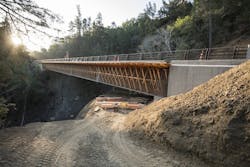No. 8 - Pfeiffer Canyon Bridge
Beginning in early January 2017, a landslide due to heavy rainfall punished Pfeiffer Canyon in Monterey County, Calif. By mid-February, the Pfeiffer Canyon Bridge on Highway 1, which was built in 1968, was determined by the California Department of Transportation (Caltrans) to be beyond repair and in need of replacement.
Closing down the bridge posed a great deal of difficulty on the Big Sur Coast community, as residents were cut off from accessing necessities like propane for heating their homes or food, and tourists could no longer reach local businesses. Due to the emergency nature of the replacement project for the bridge, most Caltrans and contractor rules were suspended to allow a seamless partnership to accelerate all aspects of the construction process.
A single 310-ft span welded steel plate girder was selected for replacing the Pfeiffer Canyon Bridge since the design and fabrication of a single span structure could begin immediately and would not be dependant upon waiting for safe access down into the canyon for foundation investigations. In addition, welded plate steel girders were the ideal choice over precast concrete girders due to weight savings that would minimize the crane size needed for erection.
Working across a deep canyon, dealing with an active landslide and needing to accomplish construction rapidly presented unique challenges for this project. The solution decided upon to make it work was to “launch” the bridge, which had never been done before on the California state highway system. This process required the structure to be completely preassembled on a flat surface like a roadbed immediately next to the area to be crossed by the bridge structure. Once the structure is assembled, it is then pulled across the canyon.
“Selecting the launch process to construct the bridge cut down on the time it took to assemble the bridge superstructure,” David Silberberger, P.E., PMP, project manager for Caltrans, told Roads & Bridges. “Launching the bridge avoided the need for building temporary towers in the canyon and on the active slide for splicing the girders, which presented risks to the workers.”
Among many items that had to be engineered for the launch process, which took place over several days, included a 100-ft scaffolding column built in the middle of the canyon which would serve as a temporary support, the placement of roller systems and guides, and a temporary nose built at the front of the assembled girders. During the launch, the assembled girders were pulled across the 310-ft canyon with the use of high-strength steel strands and hydraulic pistons.
The Pfeiffer Canyon Bridge was built and opened to the public just eight months after the original concrete structure was condemned, a process which normally would have taken about eight years to complete.
Location: Big Sur Coast, Highway 1, Calif.
Owner: Caltrans
Designer: Caltrans
Contractor: Golden State Bridge Inc.
Cost: $24 million
Length: 310 ft
Completion Date: Oct. 13, 2017
